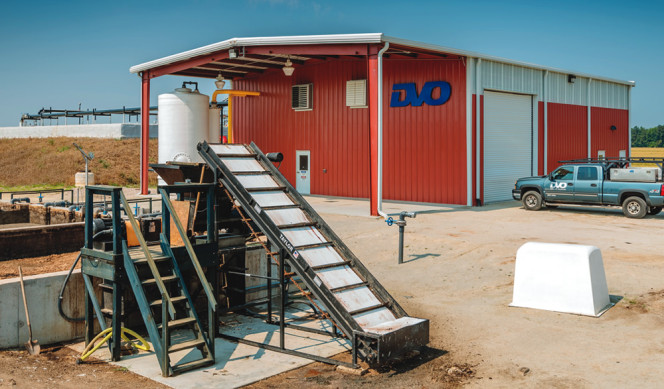BioCycle July 2014
Alexandria, Virginia: Analyzing Side Effects Of Codigestion
Among the Water Environment Research Federation (WERF) research projects in 2014, three are focusing on developing solutions to operational side effects associated with codigestion of high strength organic wastes at wastewater treatment facilities, explains Lauren Fillmore, Senior Program Director at WERF. The first project, being conducted by Hazen & Sawyer (ENER8C13), is doing a systematic evaluation and characterization of feedstocks available for use within codigestion. These include fats, oils and grease, food waste and agricultural, animal and industrial organic wastes. Impacts of adding high strength wastes on sludge treatment and handling facilities, and the changes in biosolids quantity and quality will be analyzed, along with impacts on liquid streams. Necessary upgrades and/or modification of facility infrastructure and operations will be assessed. Case study data will be obtained to help quantify the costs of implementing codigestion of various organic wastes at wastewater treatment facilities.
The second research project is being conducted by Carollo Engineers (ENER9C13), along with a researcher from Clarkson University. Its scope includes identifying key operational parameters for managing codigestion/ cofermentation processes. “The objectives of this project are to advance the knowledge of ‘real-world’ codigestion facility design, operations, performance, and maintenance for other treatment facilities evaluating codigestion for increased energy recovery,” adds Fillmore. “The project will also evaluate extensions of bench-scale anaerobic treatability testing to provide estimates of increased sludge production and final effluent nutrient concentrations for proposed supplemental organic waste(s).” Sampling will be done at a range of treatment facilities.
The third research project, being conducted by Kennedy Jenks, in collaboration with a researcher at Bucknell University (ENER12R13), is building on previous research to predict the side effects of codigestion by analyzing a combination of fundamental parameters. These parameters include chemical composition; viscosity; soluble cation concentrations; soluble and total COD (chemical oxygen demand), alkalinity, volatile fatty acids, pH, total solids, volatile solids; gas composition; surface tension; volume expansion potential (foam and gas holdup) and gas production rates; dewaterability (cake solids and polymer demand) and cake quality (odors and regrowth).
Bladenboro, North Carolina: Swine Digester Ribbon Cutting
The official ribbon cutting ceremony for a 600 kW anaerobic digester was held in late June at the Storms Hog Power (SHP) facility at the Storms Hog Farm near Bladenboro. Manure is collected daily from nearly 30,000 hogs that was formerly treated in open-air lagoons. Storms Hog Farm uses scrapers instead of flush water to remove manure from the houses. It is mixed with off-site agricultural wastes from off-site that were previously either land applied or destined for a landfill, and then loaded into a 1.2 million gallon Two-Stage Mixed Plug Flow™ anaerobic digester developed and patented by DVO, Inc. North Carolina Electric Membership Corporation purchases all of the electricity under a long-term contract. This revenue, combined with tipping fees for processing the off-site agricultural waste, the sale of the carbon credits and Renewable Energy Certificates, and the sale of other valuable by-products, support operation and maintenance of the facility. The SHP facility uses an engine generator and switch gear supplied by Martin Machinery Inc. and its sister company GenTec LLC. The plant has been in near constant operation since it came on line October 4, 2013, and has sustained peak or near peak output since April 2014.
 The concept for the project evolved from a 2010 grant for four swine farm renewable energy pilot projects administered by the North Carolina Department of Energy. AgPower Partners LLC developed the current digester project with energy and real estate developer, Jeffrey R. Smerko. It received a $1.5 million U.S. Treasury grant and sourced over $1 million in state tax credits. AgPower was able to facilitate construction and term debt financing through Cape Fear Farm Credit for the project owner and operator, William R. Storms, who is also the farm owner and operator.
The concept for the project evolved from a 2010 grant for four swine farm renewable energy pilot projects administered by the North Carolina Department of Energy. AgPower Partners LLC developed the current digester project with energy and real estate developer, Jeffrey R. Smerko. It received a $1.5 million U.S. Treasury grant and sourced over $1 million in state tax credits. AgPower was able to facilitate construction and term debt financing through Cape Fear Farm Credit for the project owner and operator, William R. Storms, who is also the farm owner and operator.
Washington, DC: Biogas Fuel Fares Well In New RFS Rule
The U.S. EPA has qualified additional renewable fuel production pathways and pathway components that could be used in producing qualifying renewable fuel under its Renewable Fuels Standard (RFS) program. This final rule, released in early July, describes EPA’s evaluation of biofuels derived from biogas fuel pathways under the RFS program. In a summary of the rule provided by U.S. EPA’s AgSTAR program, EPA qualifies the following as cellulosic and advanced fuel pathways under the RFS program:
Compressed natural gas produced from biogas from landfills, municipal wastewater treatment facility digesters, agricultural digesters, and separated MSW digesters
Liquefied natural gas produced from biogas from landfills, municipal wastewater treatment facility digesters, agricultural digesters, and separated MSW digesters
Electricity used to power electric vehicles produced from biogas from landfills, municipal wastewater treatment facility digesters, agricultural digesters, and separated MSW digesters
These pathways have the potential to provide notable volumes of cellulosic biofuel for use in complying with the RFS program, since significant volumes of advanced biofuels are already being generated for fuel made from biogas, and in many cases this same fuel will qualify for cellulosic RINs when this rule becomes effective. (RIN is a Renewable Identification Number — a serial number assigned to a batch of biofuel for the purpose of tracking its production, use, and trading, as required by EPA.) A more detailed article on the impact and benefits of this new rule on renewable biogas-derived fuels will be in an upcoming issue of BioCycle. www.epa.gov/otaq/fuels/renewablefuels/regulations.htm.













